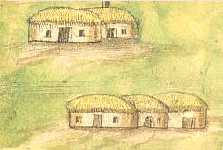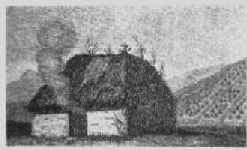
Irish cabins
From an early 17th century Ulster Plantation map.

Irish cabin
From a 19th century travel book.

Irish cabins |

Irish cabin |
Arthur Young (1741-1820), an agriculturist and writer travelled in Ireland in the years 1776 to 1778. This is how he described the houses he saw.
|
The cottages of the Irish, which are called cabins, are the most miserable looking hovels that can well be conceived; they generally consist of only one room. Mud kneaded with straw is the common material of the wall; these have only a door, which lets in light instead of a window and should let the smoke out instead of a chimney but they had rather keep it in. These two conveniences they hold so cheap that I have seen them both stopped up in stone cottages built by improving landlords. The roofs of the cabins are rafters, raised from the tops of the mud walls, and the covering varies; some are thatched with straw, potato stalks, or with heath, others only covered with sods of turf. The bad repair these roofs are kept in, a hole in the thatch being often mended with turf, and weeds sprouting from every part, gives them the appearance of a weedy dunghill, especially when the cabin is not built with regular walls, but supported on one, or perhaps on both sides by the banks of a broad dry ditch; the roof then seems a hillock, upon which perhaps the pig grazes. Some of these cabins are much less and more miserable habitations than I had ever seen in England. I was told they were the worst in Connacht, but I found it an error; I saw many in Leinster to the full as bad, and in Wicklow some worse than any in Connacht. When they are well roofed, and built not of stones ill put together, but of mud, they are much warmer, independently of smoke, than the clay or lath and mortar cottages of England, the walls of which are so thin, that a rat hole lets in the wind to the annoyance of the whole family. The furniture of the cabins is as bad as the architecture, in many consisting only of a pot for boiling their potatoes, a bit of a table, and one or two broken stools; beds are not found universally, the family lying on straw, equally partook of by cows, calves and pigs, though the luxury of styes is coming in Ireland, which excludes the poor pigs from the warmth of the bodies of their master and mistress. This is a general description, but the exceptions are very numerous. I have been in a multitude of cabins that had much useful furniture, and some even superfluous; Chairs, tables, boxes, chests of drawers, earthenware, and in short most of the articles found in a middling English cottage; but upon enquiry, I very generally found that these acquisitions were all made within the last ten years, a sure sign of a rising national prosperity. |
The mean average temperature in Ireland throughout the early modern period was some degrees lower than it is today and rivers and lakes sometimes froze over. Most people were conceived and born, lived and died in the damp Irish climate in what we would now consider extremely primitive and unacceptable housing conditions. We know little about how they managed to rear children, care for the old and the sick - in fact we have few details that would help us picture their everyday lives.